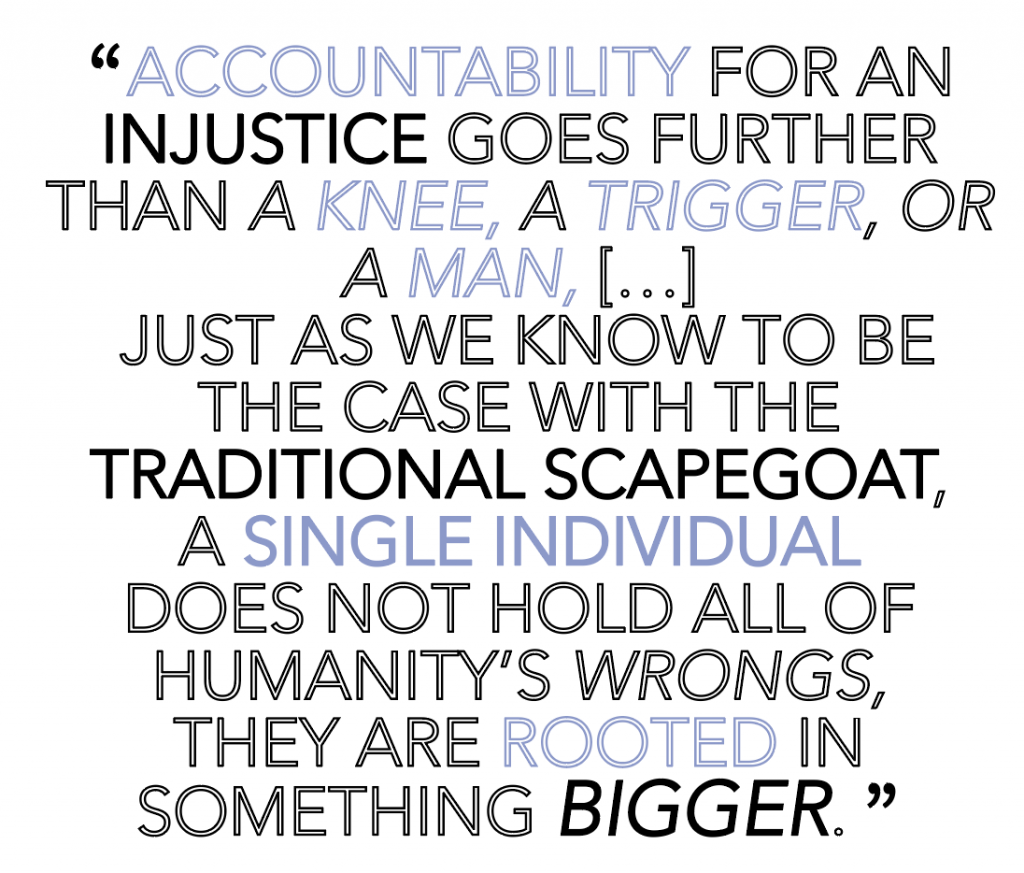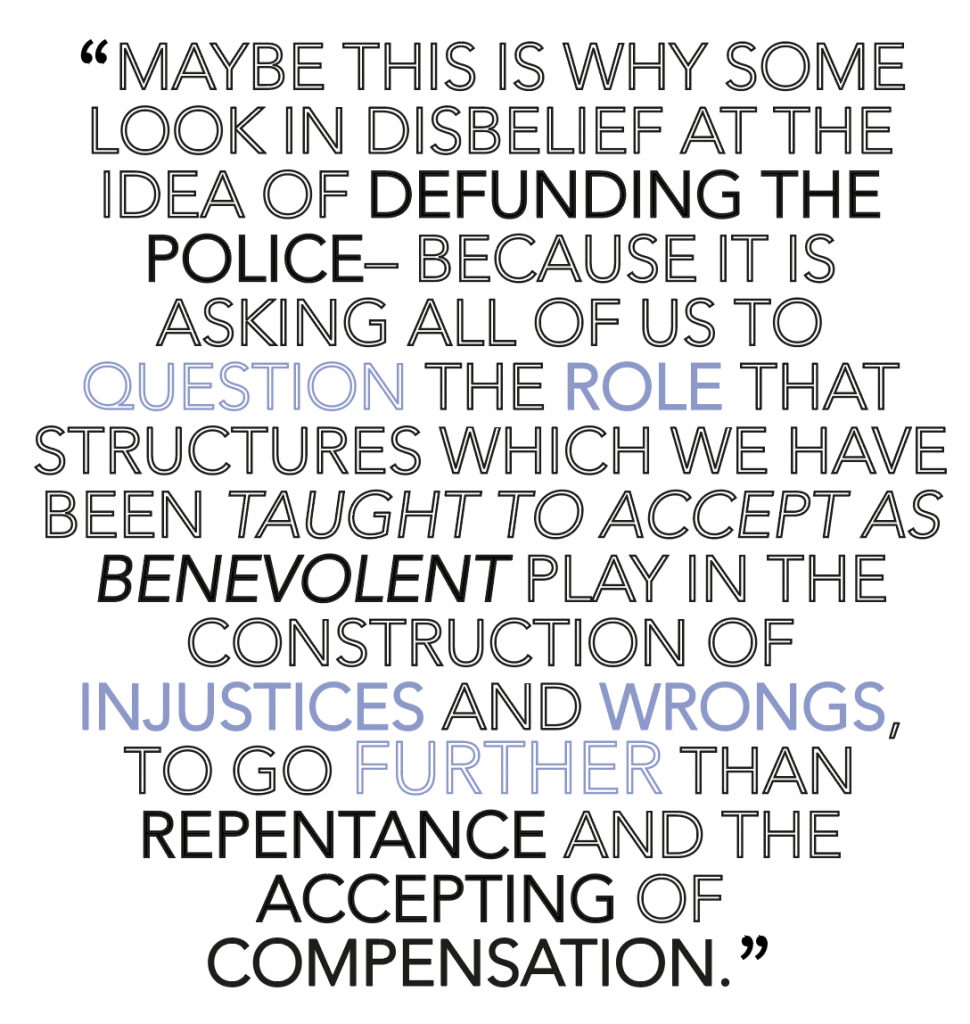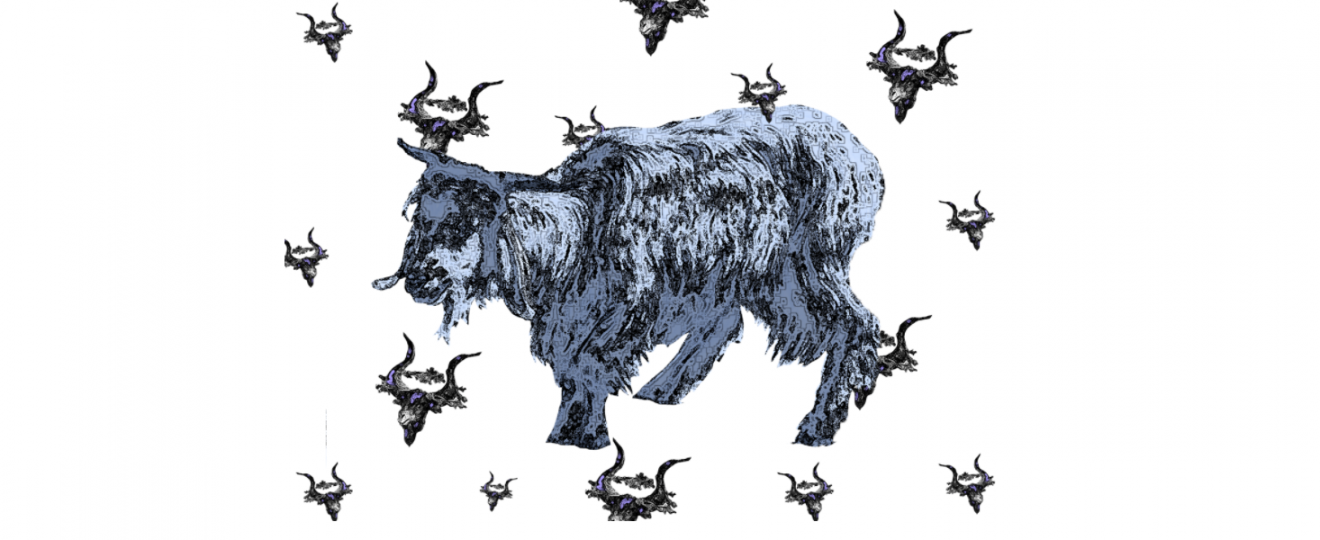I think I learnt the English word for the term first. Scapegoat. The person who is blamed for the faults or mistakes of others, the person who is made an example out of, the one who conveniently can be reduced to a symbol of what shouldn’t be done, of the punishment that would follow. I can’t remember when I first heard it, but the term (probably for obvious and redundant reasons) evoked the image of a floating goat in my mind, of the satanic version of it, twisted horns and crossed legs, a deep purple glow emanating from it. When I learnt the Spanish equivalent, chivo expiatorio, the vision in my brain’s eye only grew clearer. It caught my attention that both languages used the same symbolism for the expression– why a goat, a chivo? It rarely happens. Expiar, the verb from which the adjective expiatorio derives, means to purify one’s wrongs, to rid oneself of them. The combination of a Christian icon (yes, I took Art History in highschool) and a reference to the weight of our sins, didn’t feel like a coincidence. While I knew its exact definition, the scapegoat almost felt like a religious, mystic creature, like something other than a person washed in blame.
As it happens when one grows comfortable with the meaning of words, my curiosity over the term scapegoat slowly faded away; I still loved the aesthetic appeal of it, the glaring chivo in his defiant posture, but I treated it like any other concept, like a sealed definition, an idea embodied in words. It was only recently, while discussing the ongoing collapse of the world with my aunt, Ster, that a comment she made on the notion of responsibility made the goat descend from his floating throne and stare at me. It bleated.
In Leviticus 16:21-22 (here comes the atheist bringing up the Bible), Aaron confesses all of the sins and impurities of the people of Israel to the head of a goat, and sends it away into the wilderness, as some sort of living holder of the wrongs of the community, as the moving eraser that would free them from their mistakes. The goat that wandered off into the desert in that episode, that goat, was the original scapegoat. My younger self and my mind’s chivo look at each other– she was right; the term is somehow religious after all.
When Aaron sent his goat away, he didn’t stop to ask himself why the people of Israel had sinned in the first place, to reflect on the background issues on which the mistakes made by members of his community may have been rooted. The chivo, with its head full of whispers, was enough to clean them all away. This is the central distinction between his scapegoat and humanity’s historical version of it. Where Aaron saw some sort of godly power, or magic, for change, retrospective has allowed us to see in the traditional figure of the scapegoat the workings of a flawed system of exemplary punishment; one that is not concerned with remediating structural failures or conflicts, but with instigating fear as a control mechanism, and using individuals as props in some grander notion of responsibility. We have come (usually after the harm has been done) to see scapegoats as unwilling political tools, scapegoating as a fallacy in the defense of accountability, as the polar opposite of progressive change. Humanity has, in sum, come to terms with the fact that pinning our ‘wrongs’ on the innocent, will not revert them or eliminate them. On the contrary, it will always allow us to repeat them and, in some cases, even fuel them further. One could almost say that my mental portrayal of the scapegoat was correct– in some twisted sense, it seems satanic after all.
What we seem to have forgotten, or what most of us didn’t know in the first place, is that Aaron did not only set a goat free to redeem the populate of Israel: the scapegoat was merely one of a pair.

Before whispering sinful actions to the goat that would eventually embody a political symbol, the prophet sacrificed a different one as an offering to his god, as an atonement for the faults committed. Maybe it’s the repeated stereotypical media depictions of Yom Kippur as a ritual of sacrifice, maybe it’s the fact that episodes of animals being killed for some god are recurrent in monotheistic religions, maybe it’s the poor first goat’s lack of a catchy epitome– I don’t know why but, while we have grasped the parallelism between Aaron’s scapegoat and the historically repeated political practice, we have failed to realize that the goat that was sacrificed has also come to embody a dangerous tool against change. We seem to have completely forgotten about that other goat. The prophet’s offering was not simply a ritual gesture. It was meant to represent admission of guilt, acknowledgment of responsibility; it was meant to imply that accountability would lead to improvement. (This is, of course, my personal, rough reading; some theologians and believers may disagree but, please, allow me to pursue it for the sake of argument). That goat was a symbol too. If, in the democratic political sphere, voters are god (those who put politicians in their world in the first place, those who have the ability to remove them), and politicians are different versions of Aaron (the ones who speak for the people, who take on the role of fixing the wrongs of the community), then the prophet’s first chivo is now the nameless figure of those who, in being centrally responsible for some scandal or injustice, are removed from their positions of power, of those whose heads (in the metaphorical sense of the expression) are made roll with all the weight of Lady Justice’s sword.
Now, maybe this sounds like a stretch, like a forceful desire to see metaphors everywhere (my mind’s goat shakes its head); maybe it doesn’t, but there still doesn’t seem to be anything wrong with it at all. It’s merely the process of accountability, you could say, legal or political progress. And this latter aspect, you would be right. I am not arguing against making individuals in power answer for their faults or misjudgments, I am not suggesting that we should allow them to continue performing the roles they mishandled in the first place. Granted, this form of accountability is progressive, especially when one compares it to past (and even present in still way too many scenarios) cover-ups of responsibility and miscarriages of justice. It is undeniably necessary, it’s definitively a step forward. And yet, it’s not enough on its own. Just like scapegoating at its Cold War peak (see Sacco and Vanzetti) did but the opposite of resolving tensions and ensuring freedom, society’s contemporary use of this other figure– of the deadgoat, the outgoat, the guiltygoat call it what you will– runs contrary to long-term change.
Think back at Aaron and his goats. He didn’t just sacrifice that first one and go on to live virtuously, and neither did the people of Israel in name of whom he was apologizing: Numbers 29:7-11 of the Torah teaches Jews to sacrifice a male goat (a chivo!) as a sin offering every year on Yom Kippur, the Jewish holy day of repentance, because, year after year, the same sins are expected to be committed. Translate this thought process into any other major religion: all hold festivities of atonement and all, whether the compensation offering is a goat or not eating meat for 40 days, are based on the premise that the individual, that the community, will continue to make the same mistakes. This is why our modern political version of Aaron’s first goat is not only not good enough but also dangerous. Society accepts the head of the responsible as a symbol of redemption, as a gift– as skeptical as it sounds–, that implies the promise of the never again from those in power; we’ve been taught to see it as an acknowledgment that the act which was committed not only is unacceptable to us, but also to those in the political realm. It serves to calm down public anger because it sends the implicit message that repeated failures and tragedies can be pinned exactly on those who physically carried out the act.
This entire message is a fallacy.
Of course the agent is responsible for their acts, of course removing them from their position will prevent them from repeating the same mistake in the same kind of circumstances. Still, the background structures and mechanisms, social assumptions and beliefs, that enabled that fault, that injustice, to take place will remain the same, regardless of whether the agent is removed from the picture (metaphorically speaking) or not. Humanity seems to have reduced responsibility to the concrete level of the individual, but it is in fact much more abstract– it exists in different and complementary degrees, and it is still there even when no tragedy occurs. Think of the murder of George Floyd, and imagine that instead of Chauvin a different police officer– a calm man with a history of patience and peaceful arrests– had shown on the scene. Imagine Floyd hadn’t been murdered, imagine he had slept at home with his wife and children that night: the reality of American law enforcement corps would have still been the same, the failures and injustices that are being so eloquently voiced by the Black Lives Matter movement would have still been there. Those wrongs would have still existed. This is what the political use of the modern goat tries to conceal: the fact that accountability for an injustice goes further than a knee, a trigger, or a man, the fact that, just as we know to be the case with the traditional scapegoat, a single individual does not hold all of humanity’s wrongs, that they are rooted in something bigger.

The current surge in movements pushing for defunding American law enforcement follows this train of thought. It is premised on the warranted and correct belief that the destitution of officers, sergeants or chiefs of police will not, on its own, stop black citizens from becoming victims of police brutality. It is a call both for the recognition and amendment of the larger problem that is weaved in the entity’s DNA (from its slave patrol origins in the South, or training on the use of force), and for the need of solutions and mechanisms that will help alleviate social issues on which the corps predate (such as structural poverty and high criminalization of small ‘offenses’). It is a call for an approach that does not stop when the responsible figure is identified; one that holds other causes accountable too.
Maybe this is why some look in disbelief at the idea of defunding the police– because it is asking all of us to question the role that structures which we have been taught to accept as benevolent play in the construction of injustices and wrongs, to go further than repentance and the accepting of compensation. To demand active actions that will put an end to the naïve question of why do this kind of things keep happening?, that will drive change into the horizon, rather than in circles. The movement in favor of defunding the police is the first clear strike against Aaron’s other goat, the first push towards accepting that collective reflection and social restructuring are indispensable in the fight for something better. Its internal logic, leaving the specific nuances aside, apply to every aspect of our sociopolitical reality: from corruption scandals in Spain (in which we seem to skip the stage of asking ourselves what it is about our system that enables every political party to steal), to paedophilia in the Catholic Church and mass shootings in the US. The movement for defunding the police is telling all of us that repeated tragedies and failures are not only systematic, but also systemic. To find the solutions not simply in bodies, but in the structures that contain them.
My mind’s chivo has ascended back to its throne, its legs crossed, its glow purple, dead goats piled underneath it. It doesn’t feel magical anymore– real-life injustices weigh too heavily to be allowed to remain in the occult.
Cover image by Alcira Hava




